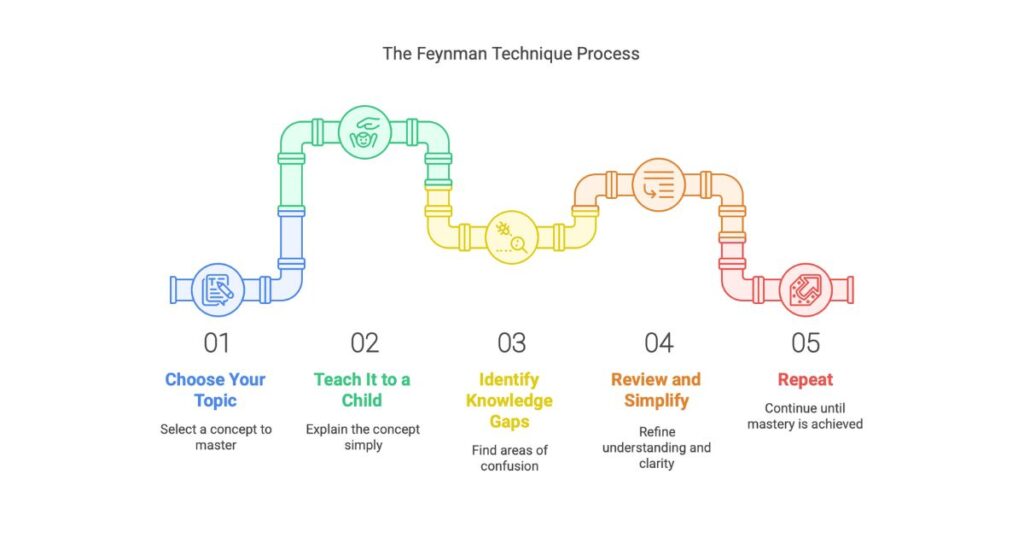Have you ever felt overwhelmed by complicated ideas, struggling to make sense of them? That’s where the Feynman Technique comes in—a simple yet effective method to help you truly understand even the toughest concepts. Let’s explore how this approach can change the way you learn and retain information.
Why to Use The Feynman Technique
Imagine being able to explain quantum physics to your grandma or break down the intricacies of blockchain to a 5-year-old. That’s the superpower the Feynman Technique gives you. It’s not just about impressing others, though. This method helps you:
- Identify gaps in your understanding
- Simplify complex ideas
- Retain information for the long haul
- Boost your confidence in any subject
By forcing you to explain concepts in simple terms, the Feynman Technique acts like a mental gym, strengthening your grasp on even the most challenging topics12.
How to Use The Feynman Technique

Ready to channel your inner Feynman? Here’s your step-by-step guide:
- Choose Your Topic: Pick a concept you want to master.
- Teach It to a Child: Explain the concept as if you’re talking to a 12-year-old. Use simple language and avoid jargon.
- Identify Knowledge Gaps: Notice where you struggle or use vague language. These are your weak spots.
- Review and Simplify: Go back to your source material. Fill in the gaps and simplify your explanation even further.
- Repeat: Keep refining until you can explain the concept effortlessly and clearly.
Real-life Implementation
Meet Sarah, a biology student struggling to understand photosynthesis. With her exam approaching, she felt completely lost—until she tried the Feynman Technique.
Sarah grabbed a whiteboard and began explaining photosynthesis as if she were teaching her younger brother. She drew simple sketches of plants, sunlight, and carbon dioxide, breaking the process into easy-to-follow steps. While explaining, she realized she couldn’t fully describe how chlorophyll worked.
Recognizing this gap, she went back to her textbook, studied the details, and simplified them further. After a few attempts, she nailed it. Not only did Sarah pass her exam with flying colors, but she also became a go-to tutor for her classmates. The Feynman Technique helped her turn confusion into confidence.
Template Framework
Ready to Feynman your way to mastery? Here’s a template to get you started:
1. Topic:
[Write your chosen concept here]
2. Child-friendly explanation:
- Main idea: [Explain in one simple sentence]
- Key points:
a. [Simple explanation of point 1]
b. [Simple explanation of point 2]
c. [Simple explanation of point 3]
3. Identified gaps:
[List areas where you struggled to explain]
4. Simplified explanation (after review):
[Rewrite your explanation, addressing the gaps]
5. Analogies or examples:
[Include 1-2 relatable comparisons to everyday concepts]
History of The Feynman Technique
The Feynman Technique wasn’t actually created by Richard Feynman himself but is inspired by his distinctive way of learning and teaching. Richard Feynman, a Nobel Prize-winning physicist, was known for his remarkable ability to break down complex scientific ideas into simple, understandable explanations.
Born in 1918, Feynman developed this method during his career as a scientist and educator. He believed that if you couldn’t explain a concept simply, you didn’t fully understand it. This idea became the foundation of what we now call the Feynman Technique.
The method gained traction in the personal development space in the early 2000s as more people recognized its power to deepen understanding and improve memory. Today, it’s widely used by students, professionals, and lifelong learners, proving that one of the best ways to learn is by teaching others.
Tools You Might Also Like:
- The 2-Minute Rule: A Simple Tool for Greater Productivity
- The Eisenhower Matrix: A Simple Tool for Better Time Management
- The Ivy Lee Method: A Simple Way to Boost Your Productivity
- The 80/20 Rule: Unlocking More with Less Effort
- The Pomodoro Technique: A Simple Tool to Boost Your Productivity
- The Seinfeld Strategy: Building Habits with Consistency